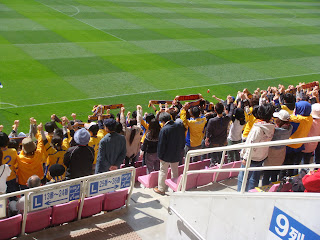Yesterday my friend Keith and I went to the Vegalta soccer match. It was the first game since the disaster. The stadium is just south of the Izumi Chuo and as promised the subway was in operation again so there was a big crowd. The funny wrinkled roof is the stadium and this is the access street from the station.
After having lunch at a cheap Italian restaurant in the station building, we arrived at the stadium about an hour and a half before game time.
These people are buying some of the few tickets that are sold on game day. Most of the tickets are either season tickets or are purchased through convenience stores or ticket outlets.
Our seats were almost into the Urara Reds' area, the opposing team, and just a hair behind the goal line. We had an excellent view of the half of the pitch in front of us but it was difficult to see what was happening at the other end.
The teams came out and warmed up. Keith and I speculated about the the line ups for the two teams.
This is the Vegalta end of the field. The teams colors are a brilliant yellow and blue. When there are thousands of people wearing this yellow it is quite impressive.
Before and during the game, there were a few unusual events. After the teams had warmed up and had returned to the dressing rooms under the stadium, A man sang the national anthem, so that does not usually happen. Then we had a minute of silence in respect of the tens of thousands of people who had died. I found it very emotional - almost 20,000 people standing in complete silence. I did not even hear any coughing. Then the mayor of Sendai and some other people gave short speeches.

As the teams were lining up to return to the pitch, I went out to the men's room and on the way back, I took this picture of Keith.
 As the teams entered the pitch to start the game, there was an extremely unusual event. Earlier they had demonstrated this but I was surprised that it actually happened. They asked everyone to hold hands with the person next to them and raise their hands high over their head. You can see in this picture that most people actually did it. Very unJapanese, but it complimented the ad campaign that is being conducted, especially on TV, saying that "We are one and together we can revive the country." It stresses working together as a country, being friends, supporting each other, and the trying hard.
As the teams entered the pitch to start the game, there was an extremely unusual event. Earlier they had demonstrated this but I was surprised that it actually happened. They asked everyone to hold hands with the person next to them and raise their hands high over their head. You can see in this picture that most people actually did it. Very unJapanese, but it complimented the ad campaign that is being conducted, especially on TV, saying that "We are one and together we can revive the country." It stresses working together as a country, being friends, supporting each other, and the trying hard.The two teams lined up in front of the main stand. Vegalta is in yellow and blue, the Reds in red and white.
It was a pretty good game and in the end Vegalta one 1 to 0.
After the finish of play, the team came over in front of us to pay their respects to the fans. The team always lines up in front of each section of the stands and bows to the audience. Then they wave and recognize individuals in the stands that they know. The man in light blue is the goal keeper. The players in dark blue are the ones who were not on the pitch at the end of the game.
The large bird is the team's mascot. He runs around on the field before and after the games and often comes up and walks round the stands, letting people take their pictures with him
All in all, it was a good day and one on which I was almost able to forget about the disaster.


















































